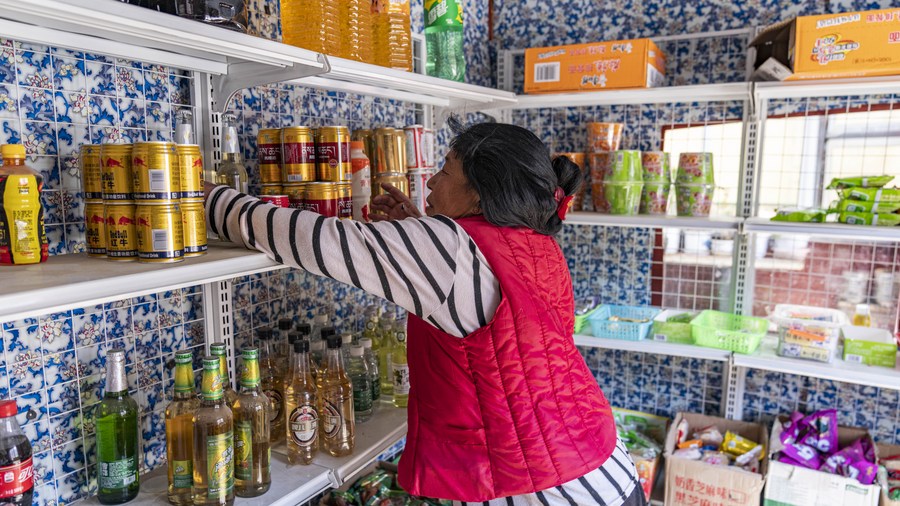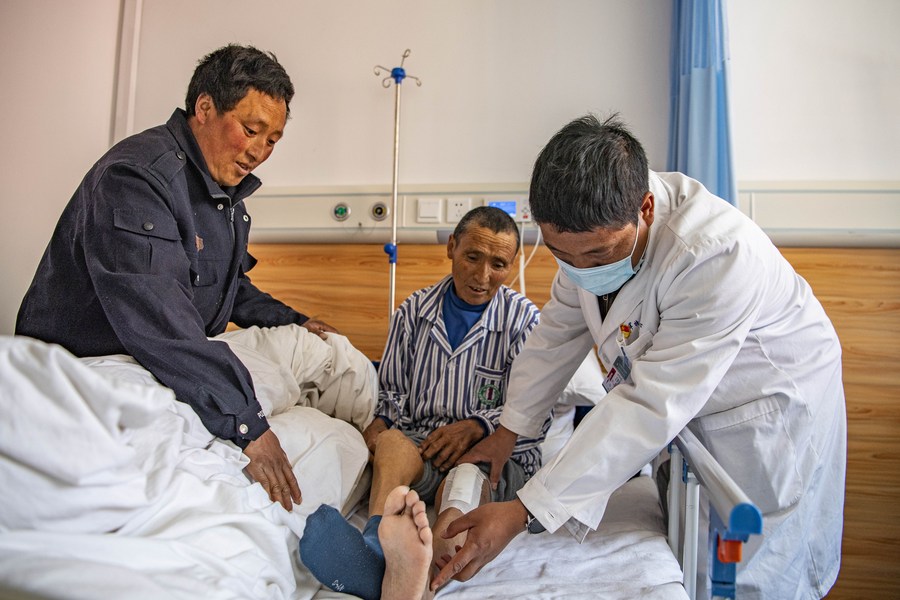
Penpa Tsomo sorts out commodities in her grocery store in Tongkong Village, the city of Qamdo, southwest China's Tibet Autonomous Region, March 29, 2021. (Xinhua/Sun Fei)
A sparkling floor, with colorful and clean tableware arranged neatly in a Tibetan-style cupboard -- it is hard to tell from the tidy interior of this home that the dweller is a patient haunted by a bone disease for years.
Forty-eight-year-old Penpa Tsomo from Tongkong Village, Qamdo City in southwest China's Tibet Autonomous Region, has lived with Kashin-Beck disease, also known as "big bone disease," since a tender age. The bone and joint disorder has left her with swollen knee joints and trouble walking freely.
The disfiguring disease, with clinical manifestations such as joint pain and muscle atrophy, can lead to dyskinesia and even disability. It was once prevalent in some of China's underdeveloped regions, such as Tibet, Qinghai and Sichuan.
The pathogenesis of this endemic disease remains confounding, but it is widely believed to be related to diet and drinking water.
Thanks to the initiative of relocation of rural residents out of inhabitable areas, part of China's poverty reduction efforts, the Penpa family moved to the village of Tongkong 10 years ago, with new housing and a safe drinking water supply in place.
"Doctors from the township health center come to check my knees and give me medicine from time to time," Penpa said. "I don't have to worry anymore."
With the relief of her pain, Penpa's livelihood also improved, as the local government supported her in opening a grocery store and granted her subsidy, ensuring her a monthly income of about 1,100 yuan (170 U.S. dollars).
Like Penpa, more than 5,700 patients in the city of Qamdo, one of the regions worst plagued by Kashin-Beck disease, have received proper treatment.
Endemic diseases, especially those raging in poverty-stricken areas, have long been a root cause of poverty or relapse into poverty. Kashin-Beck disease is no exception. Elimination of it was highlighted in poverty reduction.
On top of relocation of rural residents, the locality also took a package of measures to uproot the disease, including improvement to water and grain quality and introduction of selenium supplementation.
Villagers of Chongsar, Baxoi County of Qamdo, where the incidence of the bone disease stood high in the past, have no concern about their children's health any longer, despite children and adolescents are more vulnerable to the disease than adults.
It is attributed to a drinking water treatment project. The local government selected a quality drinking water source, and tested it to meet the drinking water standard for humans and animals, before building facilities to grant all villagers access to safe water.
So far, there were only been three newborns with suspected Kashin-Beck disease in the village, and the conditions of existing patients have been significantly alleviated.
The city of Qamdo saw the detection rate of the disease, via X-ray examination, among children aged between seven and 12, dropped from approximately 57 percent in 1999 to zero in 2019. One year later, all the 11 county-level districts in the city shook off poverty.
Prevention and treatment for endemic diseases never came late in China. The National Health Commission and other authorities jointly initiated a three-year campaign against endemic diseases in 2018, which has yielded positive results.
A children's nutrition improvement project, covering several poor areas affected by the bone disease, benefited more than 1.3 million children of six months to two years old during the past three years.
In 2019, China allocated an additional 200 million yuan from the medical assistance subsidy for patients of endemic disease in poor areas, including Kashin-Beck disease.
The country has seen no new child cases of Kashin-Beck disease for two consecutive years, and all 379 infected regions in the country had met the criteria for the elimination of the disease.

A doctor gives an examination to Tashi Sonam (C) who received a knee replacement operation in a hospital in Baxoi County, March 29, 2021. (Xinhua/Sun Fei)
Tashi Sonam, 61, received a knee replacement operation in a hospital in Baxoi County in March, free of charge.
"Before the operation, I couldn't walk even with crutches and had to take painkillers. After that, I haven't had any medicine for a few days, but I can still get out of bed and walk," he said.
"I'm looking forward to being discharged from hospital and going back home soon," said Tashi.

